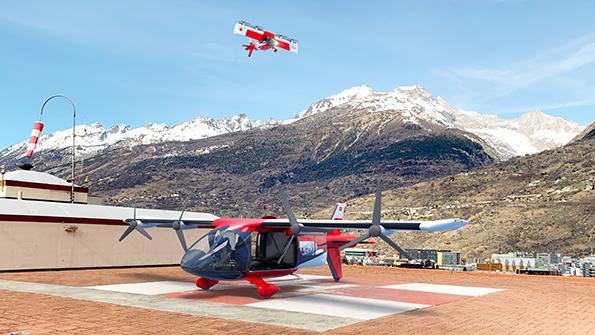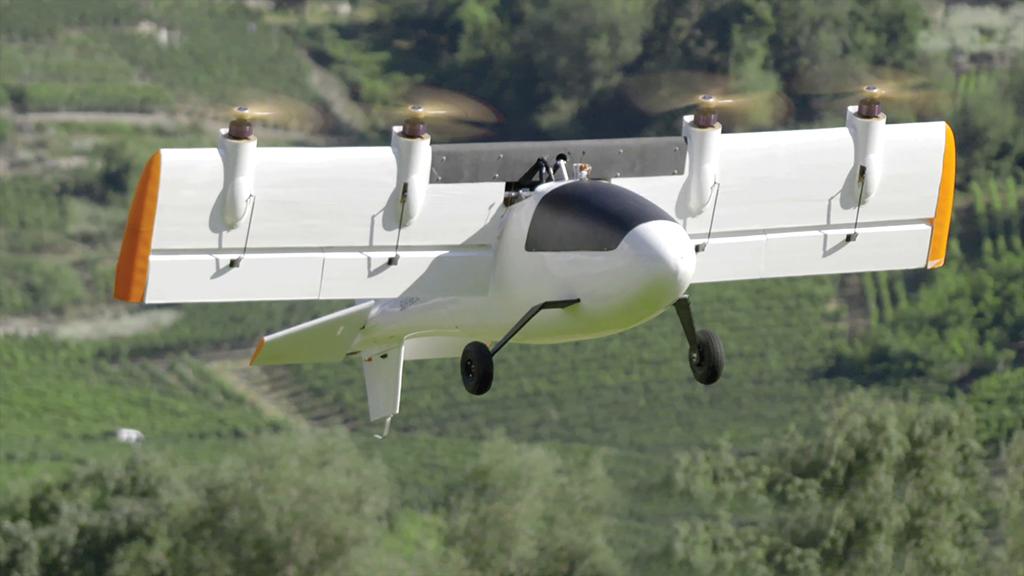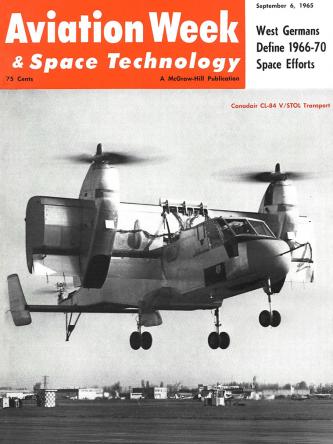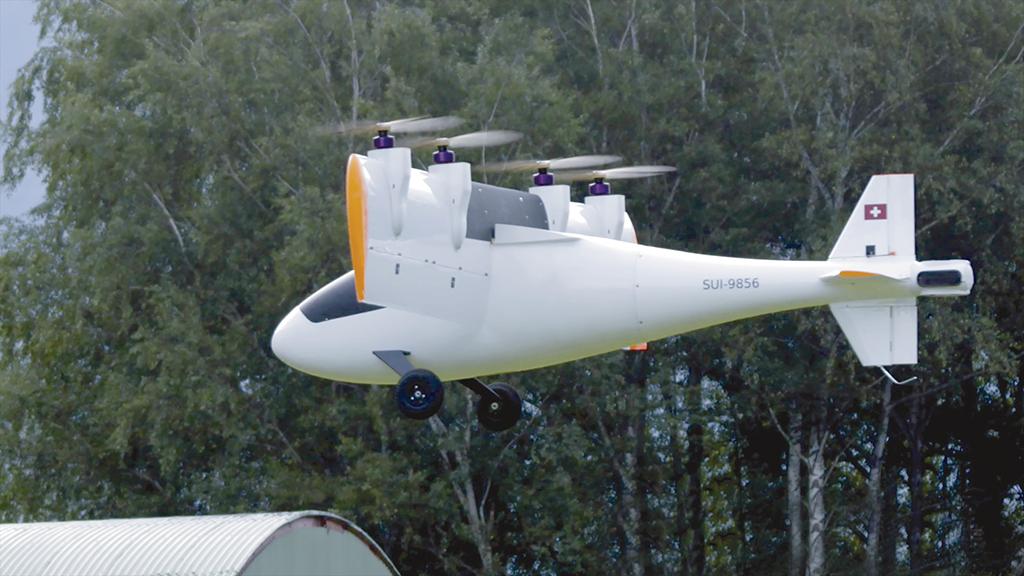
The tiltwing is an aircraft configuration waiting for its time to come. Despite successful prototype flights in the 1960s, no tiltwing design has entered production. But the emergence of electric propulsion has given the concept another chance.
- Dufour Aerospace’s large aEro3 eVTOL demonstrator has completed 550 flights
- The startup is targeting the medical transportation market
Swiss startup Dufour Aerospace has chosen the configuration for its aEro3 electric vertical-takeoff-and-landing (eVTOL) aircraft, citing the technical success of Canadair’s CL-84 Dynavert tiltwing program of 1965-75 as key to its choice.
The aEro3 will be a 5-7-seat aircraft that combines VTOL capability with cruise efficiency and speed through its tiltwing configuration and has substantially lower energy and maintenance costs than a helicopter, thanks to distributed electric propulsion.

Dufour is targeting the medical transport market initially. Thomas Pfammatter, co-founder and CEO, is a helicopter rescue pilot and past chief financial officer with Switzerland’s Air Zermatt. “That’s where our expertise comes from,” he says.
While Dufour sees the potential of eVTOL for urban and regional transport, “we believe there are a lot of hurdles to those future new markets, so we are designing aircraft that are usable for today’s operations by today’s operators,” he says.
“I would like to have an aircraft that is plug-and-playable into the operation of a regular helicopter,” Pfammatter says. “If you have an aircraft that is three or four times cheaper [to operate] than today’s helicopters, we don’t need a lot of other new markets to open up.”
The Visp-based startup began by developing electric propulsion technology. Its first project was the aEro1 electric aerobatic aircraft. A modified Silence Twister kitplane, the aEro1 was able to stay aloft for 30 min. in aerobatic flight and 60 min. in regular flight, with a 15-min. reserve.
Dufour saw an aerobatic aircraft as a usable application for electric propulsion, as it makes only short flights and does not stray far from the airfield. “That was our baseline, to make an electric aerobatic aircraft that could fly not just for 5-10 min., but a 30-min. aerobatic flight and another 15-min. reserve so you can go around if something happens,” Pfammatter says.
Having flown the aEro1 in 2016, Dufour began thinking about eVTOL concepts. “We did not want to develop anything new and saw we had to check what had already flown,” he says. “The CL-84 had a fantastic reputation and turned out well in its flight behavior—how it flies and how it transitions.”

The CL-84 was an experimental vertical/short-takeoff-and-landing (V/STOL) aircraft, a military transport/combat-support demonstrator that first flew in January 1965. Four were built, and the CL-84 logged 476 hr. over 709 flights. It was flown by 40 Canadian, U.S. and UK pilots who gave the tiltwing aircraft’s flying qualities a generally positive review.
With a 12,800-lb. VTOL gross weight and a pair of 1,500-shp Lycoming T53 turboshafts driving large-diameter, lightly loaded propellers, the CL-84 underwent flight evaluations ranging from simulated rescue missions, dropping external stores and firing a gun, to operating from an assault carrier. But the design failed to make it into production.
The same fate befell the XC-142, an experimental tiltwing developed in the U.S. by LTV with Hiller Aircraft and Ryan Aeronautical. Intended as a triservice assault transport, with a 37,500-lb. VTOL gross weight and four 3,080-shp GE T64 turboshafts, the aircraft made its first flight in September 1964. Five XC-142s logged 420 hr. over 488 flights, flown by 39 pilots.
Tests including carrier operations, simulated rescues, paratroop drops and low-level cargo extractions demonstrated the tiltwing’s capability but, like the CL-84, the XC-142 did not lead to production. The idea of a triservice V/STOL transport fell apart, only to be resurrected in the 1980s—ultimately leading to the Bell Boeing V-22 tiltrotor.
Looking back at the lessons learned, CL-84 program manager Fred Phillips in 1990 wrote that both tiltwings, while technically successful, failed because they were neither helicopters nor jets, and there were no champions for propeller aircraft within the military. He credited the tiltrotor’s success to Bell’s singular focus on rotary-wing aircraft and “prodigious perseverance over almost 40 years.”
The CL-84 was mechanically complex, with cross-shafting between the engines for safety and a “mixing box” of cams and levers that ensured stick and rudder inputs produced the same responses in vertical and forward flight by scheduling the combination of control surfaces, propellers and tail rotor as a function of wing tilt angle.
Electric propulsion and fly-by-wire flight control greatly simplify the tiltwing. “We realized that this was the path to go,” says Pfammatter. “It’s efficient in hover because the props are big, as well having a wing and not much drag from any lifting props.” Through simulation and small-scale models, Dufour has built up its understanding of the concept.
This year, the startup completed 550 test flights of a large-scale, 4.5-m-span (14-7-ft.) unmanned demonstrator. “We’ve been able to prove all of our models and simulations and demonstrate we really do understand the aerodynamics of these aircraft,” says Chief Technology Officer Jasmine Kent. “Actually, the simulation model was too conservative. The performance has been even better than we expected.”
The data gathered is being fed into the design of the flagship aEro3, which is planned to be certified under the European Union Aviation Safety Agency’s Special Condition for VTOL (SC-VTOL) regulation.
Where Dufour’s original concept had two propellers like the CL-84, the demonstrator has four, and the aEro3 could have four or six. “The number of props is a trade-off,” Pfammatter says. “An electric aircraft has to be the most efficient design because it is limited by battery technology. Two big props are more efficient. The disadvantages come from regulations.”
SC-VTOL sets a probability of catastrophic failure of 10-9 for commercial passenger-carrying eVTOLs. “If you have two props and lose one, you lose the aircraft,” says Pfammatter. “Four or more props mitigate the risk of losing one. I lose a bit of efficiency, but gain redundancy.”
The demonstrator showed another advantage. “Smaller props increase the propwash velocity, which improves handling characteristics,” says Kent. The wing is immersed in the propwash at all times. This keeps flow attached and also increases the effectiveness of the ailerons relative to a tail rotor, for yaw control in hover. A pair of impellers in the tail thrust up and down to provide pitch control in VTOL.

A tiltwing can also be flown in short and conventional takeoff-and-landing modes, Pfammatter says, the propwash flowing back over the tail, providing aerodynamic control at low airspeed. This could allow the aircraft to carry a full seven persons on commuter operations from small airports, he says.
The aEro3 is expected to be hybrid-electric. “We put in enough batteries for the vertical phases of flight plus reserves, but the additional power for cruise can be delivered at a lower rate,” Kent says. “So we can put in more batteries with a lower C [discharge] rating or a hybrid system with a range extender.”
A hybrid system will be needed initially, Pfammatter believes, because the charging infrastructure will not be there. “We have days when we fly one rescue mission, but we have days where we fly 15, one after the other. I can’t recharge my aircraft then. I have to be able to refuel, like a helicopter today.”
Dufour believes tiltwing eVTOLs can take over 80-90% of emergency medical service (EMS) helicopter operations, except for special missions such as sling loads and long-line mountain rescue. A majority of EMS operations are hospital-to-hospital transfers, and the aEro3 is projected to be three times less expensive to operate and 1.6 times faster than a helicopter.
The eVTOL is also expected to be four times faster than a ground ambulance, yet 1.1 times cheaper to operate. “If you take those hospital-to-hospital operations that are today done by ground transportation and you provide a more efficient solution, then you have increased the demand by a factor of 10-20,” Pfammatter says. The tiltwing’s speed will also increase the radius of the “golden hour,” the first hour after a traumatic injury considered most critical for successful treatment.
Dufour plans to build a full-scale experimental prototype in 2021. “As for the certification process, we have a few more years ahead of us,” says Kent. But the startup’s ambition is clear. “We want to build something that can be used for lifesaving operations by today’s helicopter operators,” says Pfammatter. “I would like to give them the best tool, with all the advantages of eVTOL like less noise and more safety.”






Comments
Ian Hollingsworth
Flight Technology Corporation